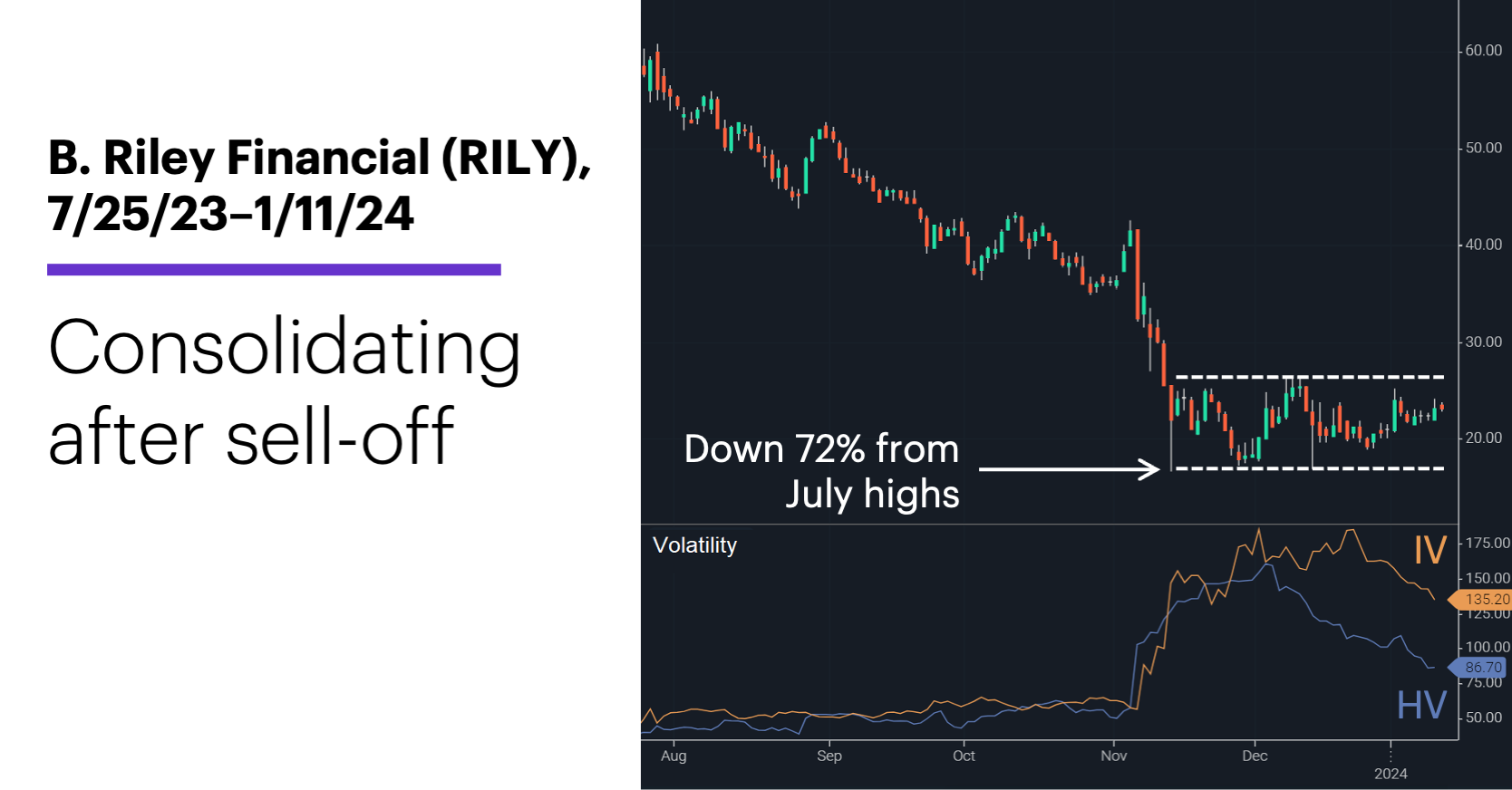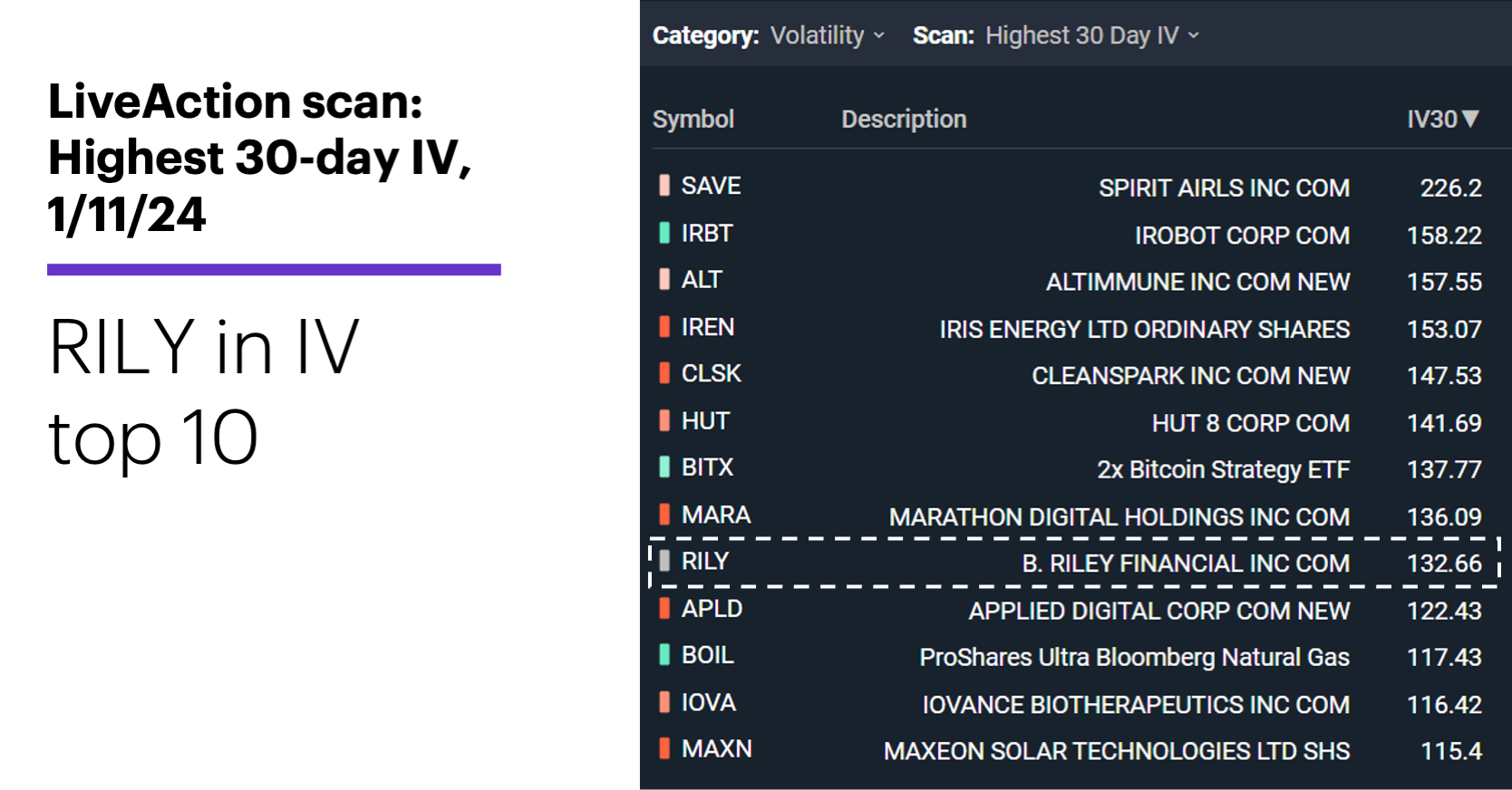Eyeing the breakout
- RILY rangebound after correction from July highs
- Options IV near highest level in three-plus years
- Options traders faced with potential breakout “roadblocks”
Many traders keep tabs on consolidating stocks to act on potential breakouts. And some options traders look to trade such situations with non-directional strategies like long straddles and strangles, which have the potential to profit regardless of whether prices break out to the upside or downside.
But as the following example illustrates, the key word is “potential.” And as is often the case with options, volatility can play a critical role in determining that potential.
B. Riley Financial (RILY) has been trading sideways for the better part of two months since tagging a nearly three-and-a-half year low of $16.65 in November:

Source: Power E*TRADE (For illustration purposes. Not a recommendation.)
The stock’s generally choppy range narrowed considerably in recent days—yesterday, RILY logged its narrowest seven-day range since June 2022.
This declining price volatility, or historical volatility (HV), stands in stark contrast to RILY’s options implied volatility (IV), which has been among the highest in the market recently:

Source: Power E*TRADE (For illustration purposes. Not a recommendation.)
The two volatility measures may be telling different stories—but not necessarily conflicting ones, since one is looking back and the other is looking ahead.
Backward-looking HV is reflecting the stock’s trading range—in effect, telling us the stock hasn’t done much lately. Forward-looking IV, however, is signaling the options market expects RILY’s volatility over the next 30 days to be higher than it was over the past 30 days.
A combination of low HV (which often accompanies trading ranges) and high IV (which signals increased potential price movement) can sound like an ideal situation for breakout traders, especially for options traders who think they may be able to capitalize on a move by using a straddle or strangle.
But the key characteristic of IV is that it’s an estimate, or forecast, of future volatility, which is ultimately as unpredictable as future price. In other words, there’s never a guarantee that the options market’s expectation for higher (or lower) volatility is correct. Also, high IV often inflates options prices, and high options prices make long straddles and strangles more expensive, which means it may take an exceptionally large price move to offset the position’s cost.
On Thursday morning, for example, an at-the-money February RILY straddle (long both the $22.50 call and put) cost approximately 7.8 ($780), which means the stock would have to be above $30.30 or below $14.70 (at expiration) for the trade to be profitable. Possible? Yes. A slam-dunk? Far from it. Both prices are well outside the stock’s recent trading range. RILY hasn’t traded above $30 since November, and it hasn’t traded below $15 since 2020.
Disconnects between IV and HV can, sometimes, signal potential breakout opportunities. But that doesn’t mean non-directional options strategies are always the best choice to trade them.
Market Mover Update: After two days of heavy trading, the Avantor (AVTR) options market took a breather on Thursday. Open interest in the February $19 put options stood at more than 32,000 after volume of 16,500 on both Tuesday and Wednesday (see “Big trades, big decisions”).
For an idea of how volatile the crude oil market’s recent consolidation has been, consider that February WTI oil futures (CLG4) rallied more than 3% intraday on Thursday and barely traded outside of Wednesday’s high-low range, and remained entirely within Monday’s range of $70.13–$70.95.
Reminder: US stock exchanges will be closed on Monday for Martin Luther King, Jr. Day.
Today’s numbers include (all times ET): Producer Price Index (8:30 a.m.).
Today’s earnings include: Bank of America (BAC), Bank New York Mellon (BK), Blackrock (BLK), Citigroup (C), Delta Air Lines (DAL), JPMorgan Chase (JPM), UnitedHealth (UNH), Wells Fargo (WFC).
Click here to log on to your account or learn more about E*TRADE's trading platforms, or follow the Company on Twitter, @ETRADE, for useful trading and investing insights.